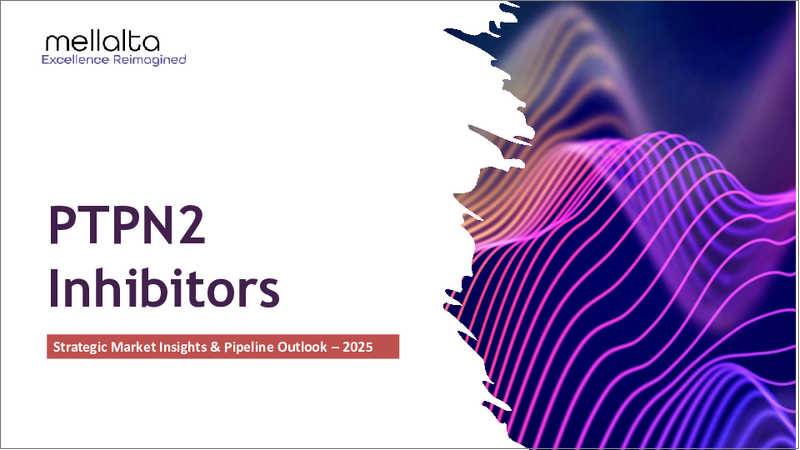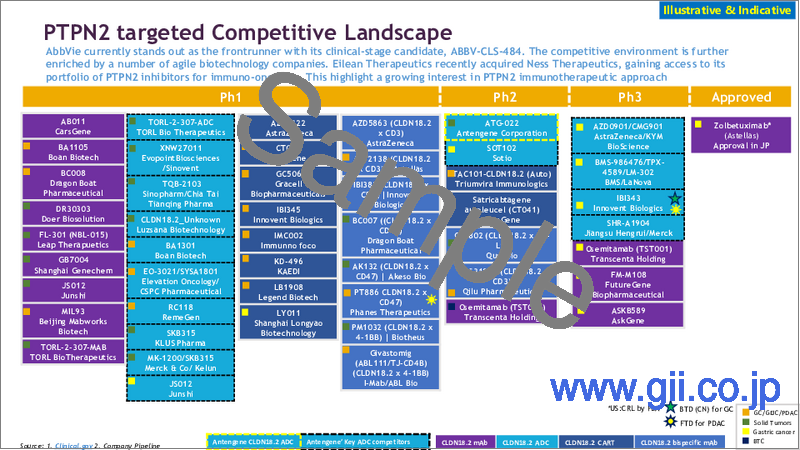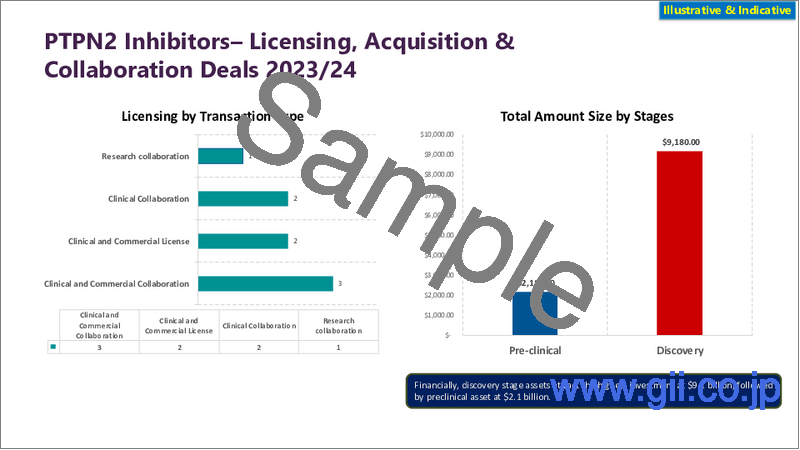|
|
市場調査レポート
商品コード
1694059
PTPN2阻害剤:戦略的市場の洞察とパイプラインの展望-2025年PTPN2 Inhibitors: Strategic Market Insights & Pipeline Outlook - 2025 |
||||||
|
|||||||
| PTPN2阻害剤:戦略的市場の洞察とパイプラインの展望-2025年 |
|
出版日: 2025年04月01日
発行: Mellalta Meets LLP
ページ情報: 英文 100 Pages
納期: 7~10営業日
|
全表示
- 概要
- 目次
何年もの間、PTPN2は"undruggable"(治療不可能)な標的というレッテルを貼られてきました。PTPN2阻害剤は現在、免疫療法における有力な候補として台頭してきています。多くの企業がこれらの低分子化合物の開発に積極的に取り組んでおり、この分野はもはや「もし」ではなく、これらの化合物が意味のある臨床的検証に「どれだけ早く」到達できるかにかかっています。
免疫チェックポイント阻害剤の市場規模は現在、2023年に484億2,000万米ドル、2030年には1,542億5,000万米ドルに達すると予測されており、がん罹患率の上昇、ヘルスケア支出の増加、チェックポイント阻害剤の用途拡大により、CAGR 17.9%で成長する見込みです。
チェックポイント阻害剤(PD-1、PD-L1、CTLA-4)はがん治療に革命をもたらしましたが、業界は今、すべての腫瘍が反応しないという新たな現実に直面しています。PTPN2阻害剤は、細胞表面のレセプターをブロックする代わりに、細胞内で働いてT細胞の活性化を促進します。この細胞内免疫調節は、標準的な免疫療法に失敗した患者に新たな反応をもたらす可能性があります。
ABBV-CLS-484(AbbVie/Calico)は進行性固形がんを対象に臨床試験中です。AbbVieとCalico Life Sciencesは、がんを含む加齢と加齢関連疾患に焦点を当て、10億米ドルの追加投資で提携を拡大しました。Boehringer IngelheimはNerio Therapeuticsを13億米ドルで買収し、PTPN1とPTPN2を倍増させました。
Eilean TherapeuticsはNess Therapeuticsを買収し、安全性プロファイルを改善したクラス最高のPTPN2阻害剤の開発を目指します。Eilean TherapeuticsはExpert Systemsとの提携を拡大し、AIを活用した創薬を統合することで、PTPN2阻害剤の開発を加速させています。
当レポートでは、世界のPTPN2阻害剤市場について調査し、市場の現状とともに、買収、ライセンシングおよび提携契約、競合情勢、市場の機会などを提供しています。
目次
第1章 報告書の概要
第2章 概要
- PTPN2阻害剤のイントロダクションと役割
- PTPN2阻害剤に関する潜在的な懸念
- PTPN2阻害剤:腫瘍学における非常に有望な標的
- PTPN2阻害剤の臨床応用
第3章 PTPN2阻害剤パイプライン分析
- 概要
- 適応症/相別の資産
- 開発段階別のパイプライン製品
- PTPN2阻害剤の競合情勢
- 企業別および相別のパイプライン製品
- PTPN2阻害剤の臨床および規制タイムライン
第4章 PTPN2阻害剤の買収、ライセンシングおよび提携契約
- PTPN2阻害剤の買収、ライセンシングおよび取引価値
- PTPN2阻害剤の買収、ライセンシング(取引タイプ別、相別総額)
- 開発中の有望な技術
第5章 PTPN2阻害剤パイプラインの情勢
- プロファイルの概要
- 後期段階の資産比較の概要
- PTPN2阻害剤パイプライン薬剤プロファイル
- ABBV CLS 579(AbbVie/Calico Life Sciences)
- ABBV CLS 484(AbbVie/Calico Life Sciences)
- AB-1015(Arsenal bio)
- HDM 2010(Hangzhou Zhongmei Huadong Pharmaceutical)
- PTPN2阻害剤(Eilean Therapeutics)
- PTPN1/N2阻害剤(Boehringer Ingelheim)
- その他
第6章 PTPN2阻害剤の将来展望
第7章 SWOT分析
第8章 付録
For years, PTPN2 has been labeled as an "undruggable" target-a challenge too complex, a surface too shallow. But the industry has learned that what was undruggable yesterday becomes tomorrow's breakthrough, and PTPN2 inhibitors are now emerging as a serious contender in immunotherapy. With many companies actively developing these small molecules, the field is no longer about "if" but "how fast" these assets can reach meaningful clinical validation.
The immune checkpoint inhibitors market is currently valued at $48.42 billion in 2023, projected to reach $154.25 billion by 2030, growing at a CAGR of 17.9% due to the rising cancer prevalence, increased healthcare expenditure, and expanding applications of checkpoint inhibitors.
The Science: What Makes PTPN2 Different?
Checkpoint inhibitors (PD-1, PD-L1, CTLA-4) revolutionized cancer care, but the industry is now facing a new reality-not all tumors respond. PTPN2 inhibitors offer an alternative, working inside the cell to enhance T-cell activation instead of blocking receptors on the surface. This intracellular immune modulation could unlock new responses in patients who fail standard immunotherapies.
The Market: A Race for Clinical Validation
Despite their potential, PTPN2 inhibitors are still in early-stage development-but the right players are making big bets:
- ABBV-CLS-484 (AbbVie/Calico) is in trials for advanced solid tumors. AbbVie and Calico Life Sciences extended their partnership with an additional $1 billion investment, focusing on aging and age-related diseases, including oncology.
- Boehringer Ingelheim made a $1.3 billion move by acquiring Nerio Therapeutics, doubling down on PTPN1 and PTPN2.
- Eilean Therapeutics acquired Ness Therapeutics, aiming to develop best-in-class PTPN2 inhibitors with improved safety profiles. Eilean Therapeutics expanded its collaboration with Expert Systems, integrating AI-driven drug discovery to accelerate PTPN2 inhibitor development
Challenges & Development Hurdles
Despite promising therapeutic potential, PTPN2 inhibitors face key development challenges:
- Unfavorable pharmacokinetics, due to the highly cationic active site and shallow protein surface.
- Clinical uncertainties, with many candidates in early-stage trials requiring further validation.
- Need for combination therapies, often tested alongside anti-PD-1 therapies to enhance efficacy.
Market & Pipeline Insights: 2025 Report Highlights
The PTPN2 Inhibitor - Pipeline Analytics 2025 Report by Mellalta Meets provides an in-depth analysis of the market opportunity and competitive landscape across multiple indications, including oncology, cardiovascular, and cognitive disorders.
Key coverage areas include:
- Competitive Analysis - Breakdown of Companies and Products (Discovery to phase III)
- Pipeline Drug Profiles - Stages of development, intervention types, clinical trials
- Clinical Developments - Trials by region, efficacy outcomes, safety considerations
- Business & Investment Trends - Licensing agreements, funding, and collaborations
- Strategic Opportunities - Market drivers, challenges, and future outlook
- Recent and upcoming events
Table of Content
1. REPORT OVERVIEW
2. OVERVIEW
- 2.1. Introduction and Role of PTPN2 inhibitors
- 2.2. Potential Concern with PTPN2 inhibitors
- 2.3. PTPN2 inhibitors: A Highly-Potential Target in Oncology
- 2.4. Clinical Applications of PTPN2 inhibitors
3. PTPN2 INHIBITOR PIPELINE ANALYSIS
- 3.1. Overview
- 3.2. Assets by Indication/Phase
- 3.3. Pipeline Products by Stage of Development
- 3.4. PTPN2 inhibitor Competitive Landscape
- 3.5. Pipeline Products by Company and Phases
- 3.6. PTPN2 inhibitor Clinical & Regulatory Timelines
4. PTPN2 INHIBITOR ACQUISITIONS, LICENSING AND COLLABORATION DEALS
- 4.1. PTPN2 inhibitor Acquisitions, Licensing and Deal values
- 4.2. PTPN2 inhibitor Acquisitions, Licensing by Transaction type and total amount size by Phases
- 4.3. Promising Technologies Under development
5. PTPN2 inhibitor PIPELINE LANDSCAPE
- 5.1. Profile at Glance
- 5.2. Late-Stage Assets Comparisons At-a-glance
- 5.3. PTPN2 inhibitor Pipeline Drug Profiles
- 5.3.1. ABBV CLS 579 (AbbVie/Calico Life Sciences)
- 5.3.1.1. Product Profile & Description
- 5.3.1.2. Collaborations
- 5.3.1.3. Other Developments
- 5.3.1.4. Clinical Trials
- 5.3.2. ABBV CLS 484 (AbbVie/Calico Life Sciences)
- 5.3.2.1. Product Profile & Description
- 5.3.2.2. Collaborations
- 5.3.2.3. Other Developments
- 5.3.2.4. Clinical Trials
- 5.3.3. AB-1015 (Arsenal bio)
- 5.3.3.1. Product Profile & Description
- 5.3.3.2. Collaborations
- 5.3.3.3. Other Developments
- 5.3.3.4. Clinical Trials
- 5.3.4. HDM 2010 (Hangzhou Zhongmei Huadong Pharmaceutical)
- 5.3.4.1. Product Profile & Description
- 5.3.4.2. Collaborations
- 5.3.4.3. Other Developments
- 5.3.5. PTPN2 inhibitors (Eilean Therapeutics)
- 5.3.5.1. Product Profile & Description
- 5.3.5.2. Collaborations
- 5.3.5.3. Other Developments
- 5.3.6. PTPN1/N2 inhibitors (Boehringer Ingelheim)
- 5.3.6.1. Product Profile & Description
- 5.3.6.2. Collaborations
- 5.3.6.3. Other Developments
- 5.3.7. Others...
- 5.3.1. ABBV CLS 579 (AbbVie/Calico Life Sciences)





